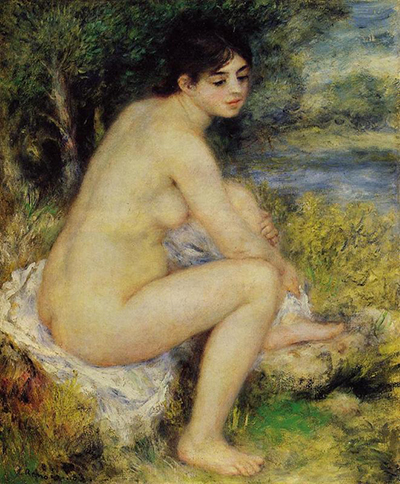In Seated Bather (1883) by Pierre Auguste Renoir, we see a nude young woman seated underneath a tree
She is drying her feet with the length of fabric that she is seated upon, implying that she has been bathing in the nearby pond. The artist has rendered the towel in white and blue tones, the same blue as the pond and the corner of visible sky.
The woman’s locks of dusky hair pick up the darker tones of the forest behind her and cast her pale face into relief. The teeming vegetation surrounding Renoir’s woman suggests that the scene is set in high summer, confirmed by the opalescent tinge on her skin drawn forth by a sun that the viewer cannot see.
Renoir’s rendering of the woman emerging from bathing is in accord with the paintings of his contemporaries, most notably Edgar Degas, who made many paintings of nude and semi-nude women in actual bathrooms.
Female and male nude statues have featured in art since classical times. Greek scholars eulogized on perfection and sculptors sought to render the human body as a perfect form. Ancient Greece saw the birth of the Olympic and Isthmian games. Young men competed nude to win prizes, while in Sparta, men and young women competed nude together.
In later centuries, the Romans venerated the nude, but to illustrate their mythology rather than physical perfection. The most famous nude of Roman times is Venus de Milo, which dates from about 100 BC. The arms of the statue have been lost, but mythological references suggest that Venus was emerging from the sea.
With the coming of Christianity, the nude fell from grace, being too pagan and sensual for church and basilica interiors. The nude did not become fashionable again until the Renaissance saw the rebirth of classicism in art.
Following Michelangelo’s renderings of nudes upon the Sistine Chapel ceiling, the nude was acceptable once more, the depiction of man as created by God and without the need for hampering by clothing. However, not all artists rendered the nude in the service of religion.
In The Tempest (c.1508) by Italian artist Giorgione, a young woman seated under a tree is suckling a baby. Apart from a strip of fabric thrown over her shoulders and wound underneath her, she is naked. In the background, a storm rages over a river and in the foreground, a soldier gazes at her prone figure.
Critics have offered various interpretations of The Tempest, but whatever the conclusion, the image is unsettling. The storm suggests the violation of nature in the way that the gaze of the man violates the woman. Roman mythology and the themes of Giorgione’s painting converge in Seated Bather. You will also see clear similarities between Sleeping Venus and Olympia by Edouard Manet.
Like Venus, Renoir’s young woman has just emerged from water but the atmosphere is serene in contrast to the violence of Giorgione’s painting. Whereas The Tempest seems to mock the myth of Venus, Renoir serves the viewer a piece of beauty. The woman’s body is not ideal; indeed, to the modern eye, she is positively overweight.
But Renoir’s impressionist technique harmonizes the opalescent tones of her skin with those of the vegetation and the water, the sky and length of towel, transforming her from just a bather into a lovely nymph, a true spirit of nature.




